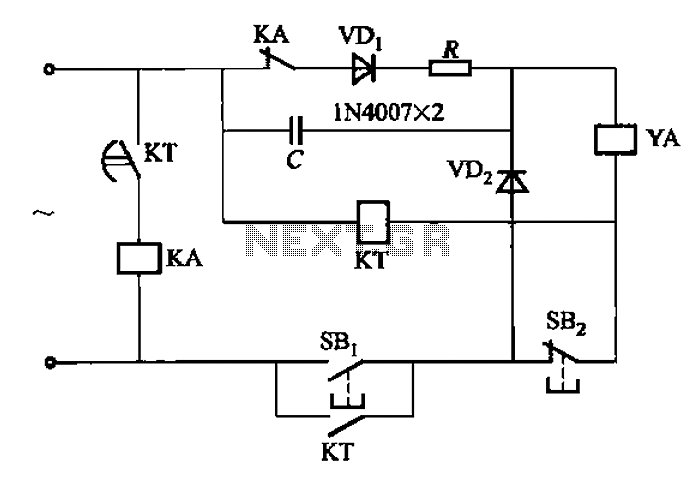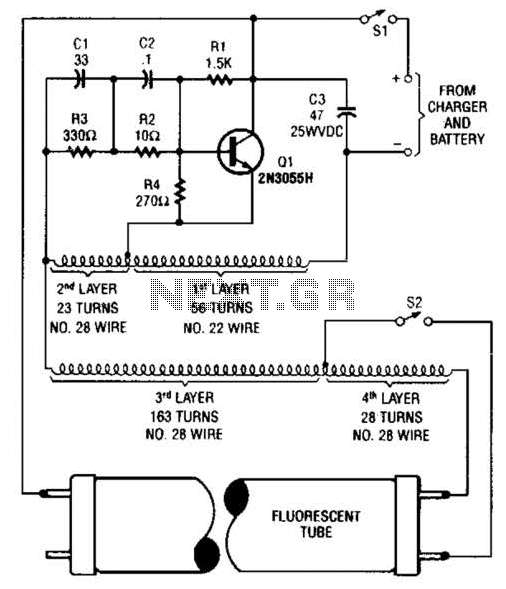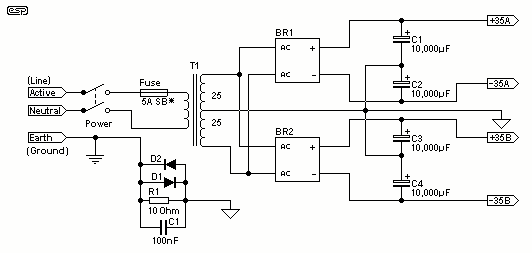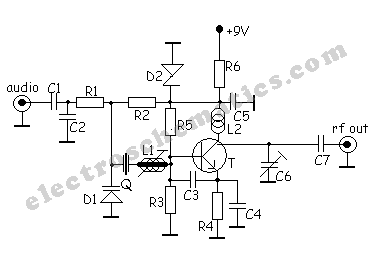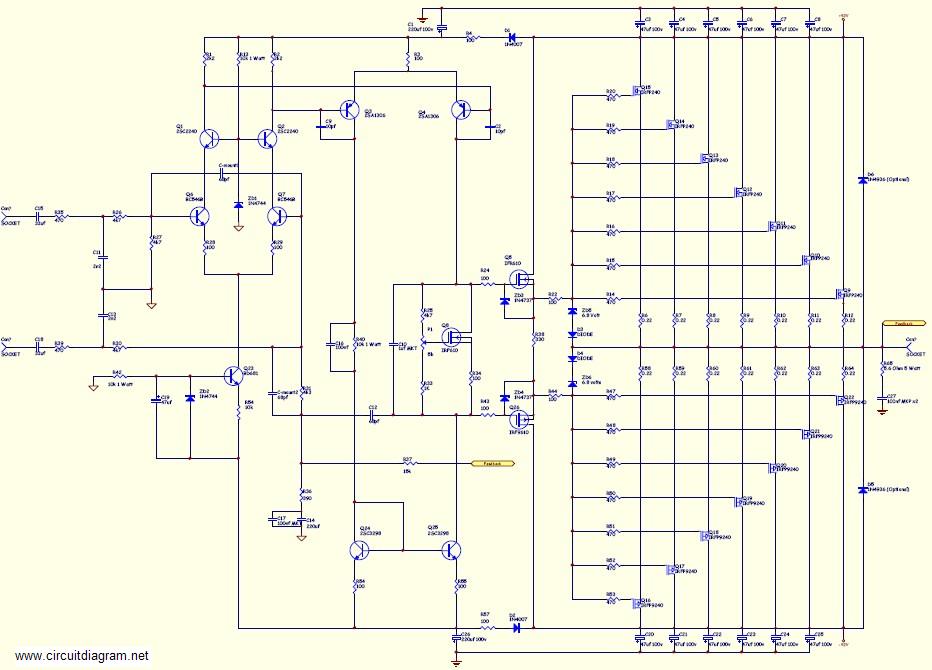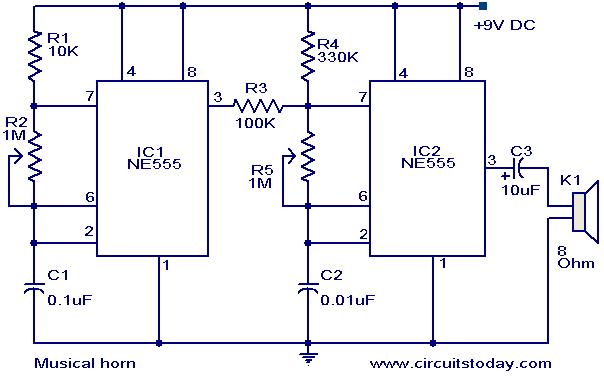
Amplifier Timer Circuit Schematic
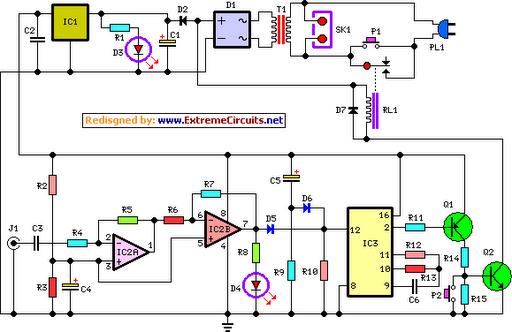
This circuit deactivates an amplifier or any connected device when a low-level audio signal is absent at its input for at least 15 minutes. Activating switch P1 powers the device, enabling operation of any appliance connected to SK1. The input audio signal is amplified and squared by operational amplifiers IC2A and IC2B, with the status monitored by LED D4. When D4 lights up, even briefly, capacitor C3 is reset, restarting its timing cycle. Pin 2 of IC3 remains low, keeping two transistors on and the relay activated. If no signal is detected at the input after the 15-minute delay, IC3 completes its timing, causing pin 2 to go high. This results in transistors Q1 and Q2 ceasing conduction, which deactivates the relay. Consequently, the device and any appliances connected to SK1 are completely powered off. Capacitor C5 and resistor R9 reset IC3 upon power-on, while switch P2 allows for immediate shutdown.
The circuit operates as a low-signal timer and power management system, suitable for applications where devices need to conserve energy by shutting down after a period of inactivity. The core of the circuit is built around the timer IC, which is configured to count the absence of an audio signal. The operational amplifiers (IC2A and IC2B) serve to enhance the input signal, ensuring that even weak audio signals can be detected effectively. The LED (D4) provides a visual indication of signal presence, which is crucial for troubleshooting and verification of the circuit's operation.
The timing mechanism is based on a capacitor (C3) that charges and discharges based on the input signal's presence. When the audio signal is detected, the capacitor is reset, preventing the timer from reaching its cutoff threshold. The two transistors (Q1 and Q2) are configured in such a way that they control the relay, allowing for the switching of higher power loads through SK1. This design ensures that the connected appliances are only powered when there is an active audio signal, thereby enhancing energy efficiency.
The inclusion of capacitor C5 and resistor R9 ensures that the timer IC (IC3) is reset upon initial power-up, providing a reliable start condition. Switch P2 offers manual control, allowing users to override the automatic shut-off feature and turn off the device at any time. This comprehensive design effectively balances automated control with user intervention, making it suitable for various audio-related applications where energy conservation is a priority.This circuit turns-off an amplifier or any other device when a low level audio signal fed to its input is absent for 15 minutes at least. Pushing P1 the device is switched-on feeding any appliance connected to SK1. Input audio signal is boosted and squared by IC2A & IC2B and monitored by LED D4. When D4 illuminates, albeit for a very short peak, I C3 is reset and restarts its counting. Pin 2 of IC3 remains in the low state, the two transistors are on and the relay operates. When, after a 15 minutes delay, no signal appeared at the input, IC3 ends its counting and pin 2 goes high. Q1 & Q2 stop conducting and the relay switches-off. The device is thus completely off as also are the appliances connected to SK1. C5 & R9 reset IC3 at power-on. P2 allows switch-off at any moment. 🔗 External reference
The circuit operates as a low-signal timer and power management system, suitable for applications where devices need to conserve energy by shutting down after a period of inactivity. The core of the circuit is built around the timer IC, which is configured to count the absence of an audio signal. The operational amplifiers (IC2A and IC2B) serve to enhance the input signal, ensuring that even weak audio signals can be detected effectively. The LED (D4) provides a visual indication of signal presence, which is crucial for troubleshooting and verification of the circuit's operation.
The timing mechanism is based on a capacitor (C3) that charges and discharges based on the input signal's presence. When the audio signal is detected, the capacitor is reset, preventing the timer from reaching its cutoff threshold. The two transistors (Q1 and Q2) are configured in such a way that they control the relay, allowing for the switching of higher power loads through SK1. This design ensures that the connected appliances are only powered when there is an active audio signal, thereby enhancing energy efficiency.
The inclusion of capacitor C5 and resistor R9 ensures that the timer IC (IC3) is reset upon initial power-up, providing a reliable start condition. Switch P2 offers manual control, allowing users to override the automatic shut-off feature and turn off the device at any time. This comprehensive design effectively balances automated control with user intervention, making it suitable for various audio-related applications where energy conservation is a priority.This circuit turns-off an amplifier or any other device when a low level audio signal fed to its input is absent for 15 minutes at least. Pushing P1 the device is switched-on feeding any appliance connected to SK1. Input audio signal is boosted and squared by IC2A & IC2B and monitored by LED D4. When D4 illuminates, albeit for a very short peak, I C3 is reset and restarts its counting. Pin 2 of IC3 remains in the low state, the two transistors are on and the relay operates. When, after a 15 minutes delay, no signal appeared at the input, IC3 ends its counting and pin 2 goes high. Q1 & Q2 stop conducting and the relay switches-off. The device is thus completely off as also are the appliances connected to SK1. C5 & R9 reset IC3 at power-on. P2 allows switch-off at any moment. 🔗 External reference
